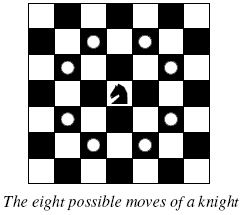Problem Description
 Background
Background The knight is getting bored of seeing the same black and white squares again and again and has decided to make a journey
around the world. Whenever a knight moves, it is two squares in one direction and one square perpendicular to this. The world of a knight is the chessboard he is living on. Our knight lives on a chessboard that has a smaller area than a regular 8 * 8 board, but it is still rectangular. Can you help this adventurous knight to make travel plans?
Problem
Find a path such that the knight visits every square once. The knight can start and end on any square of the board.
Input
The input begins with a positive integer n in the first line. The following lines contain n test cases. Each test case consists of a single line with two positive integers p and q, such that 1 <= p * q <= 26. This represents a p * q chessboard, where p describes
how many different square numbers 1, . . . , p exist, q describes how many different square letters exist. These are the first q letters of the Latin alphabet: A, . . .
Output
The output for every scenario begins with a line containing "Scenario #i:", where i is the number of the scenario starting at 1. Then print a single line containing the lexicographically first path that visits all squares of the chessboard with knight moves
followed by an empty line. The path should be given on a single line by concatenating the names of the visited squares. Each square name consists of a capital letter followed by a number.
If no such path exist, you should output impossible on a single line.
If no such path exist, you should output impossible on a single line.
Sample Input
3 1 1 2 3 4 3
Sample Output
Scenario #1: A1 Scenario #2: impossible Scenario #3: A1B3C1A2B4C2A3B1C3A4B2C4如果存在那样的路线,则从任意一点出发都一定能走遍全图,直接用dfs搜索。注意!!答案要求从左到右,从下到上。#include<cstdio> #include<cstring> #include<algorithm> #include<iostream> #include<string> #include<map> #include<queue> #include<cmath> #include<vector> using namespace std; bool vis[50][50]; int n,m; int path[10000]; int dx[]={-1,1,-2,2, -2,2,-1,1}; //方向数组一定要这样写 int dy[]={-2,-2,-1,-1 ,1,1,2,2}; bool istrue(int x,int y) { if(x>=0&&x<n&&y>=0&&y<m) return 1; return 0; } void out() { for(int i=0;i<n*m;i++) { printf("%c%d",(path[i]%m)+'A',path[i]/m+1); } printf("\n"); } bool dfs(int x,int y,int k) { if(k==n*m) { out(); return 1; } for(int i=0;i<8;i++) { if(istrue(x+dx[i],y+dy[i])&&!vis[x+dx[i]][y+dy[i]]) { path[k]=(x+dx[i])*m+y+dy[i]; vis[x+dx[i]][y+dy[i]]=1; if(dfs(x+dx[i],y+dy[i],k+1)) return 1; vis[x+dx[i]][y+dy[i]]=0; } } return 0; } int main() { int t; scanf("%d",&t); for(int tt=1;tt<=t;tt++) { scanf("%d %d",&n,&m); printf("Scenario #%d:\n",tt); memset(vis,0,sizeof(vis)); path[0]=0; vis[0][0]=1; //把起点安排在0,0 if(!dfs(0,0,1)) printf("impossible\n"); printf("\n"); } return 0; }





 本文探讨了一个经典的计算机科学问题——骑士周游问题。该问题要求在一个缩小版的国际象棋棋盘上找到一条路径,使得骑士能够访问每一个方格恰好一次。文章提供了具体的实现算法,并附带了完整的代码示例。
本文探讨了一个经典的计算机科学问题——骑士周游问题。该问题要求在一个缩小版的国际象棋棋盘上找到一条路径,使得骑士能够访问每一个方格恰好一次。文章提供了具体的实现算法,并附带了完整的代码示例。


















 被折叠的 条评论
为什么被折叠?
被折叠的 条评论
为什么被折叠?










